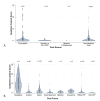Social Media Content of Idiopathic Pulmonary Fibrosis Groups and Pages on Facebook: Cross-sectional Analysis
- PMID: 34057425
- PMCID: PMC8204239
- DOI: 10.2196/24199
Social Media Content of Idiopathic Pulmonary Fibrosis Groups and Pages on Facebook: Cross-sectional Analysis
Abstract
Background: Patients use Facebook as a resource for medical information. We analyzed posts on idiopathic pulmonary fibrosis (IPF)-related Facebook groups and pages for the presence of guideline content, user engagement, and usefulness.
Objective: The objective of this study was to describe and analyze posts from Facebook groups and pages that primarily focus on IPF-related content.
Methods: Cross-sectional analysis was performed on a single date, identifying Facebook groups and pages resulting from separately searching "IPF" and "idiopathic pulmonary fibrosis." For inclusion, groups and pages needed to meet either search term and be in English, publicly available, and relevant to IPF. Every 10th post was assessed for general characteristics, source, focus, and user engagement metrics. Posts were analyzed for presence of IPF guideline content, useful scientific information (eg, scientific publications), useful support information (eg, information about support groups), and potentially harmful information.
Results: Eligibility criteria were met by 12 groups and 27 pages, leading to analysis of 523 posts. Of these, 42% contained guideline content, 24% provided useful support, 20% provided useful scientific information, and 5% contained potentially harmful information. The most common post source was nonmedical users (85%). Posts most frequently focused on IPF-related news (29%). Posts containing any guideline content had fewer likes or comments and a higher likelihood of containing potentially harmful content. Posts containing useful supportive information had more likes, shares, and comments.
Conclusions: Facebook contains useful information about IPF, but posts with misinformation and less guideline content have higher user engagement, making them more visible. Identifying ways to help patients with IPF discriminate between useful and harmful information on Facebook and other social media platforms is an important task for health care professionals.
Keywords: idiopathic pulmonary fibrosis; internet; interstitial lung disease; patient education; social media.
©Andrew Kochan, Shaun Ong, Sabina Guler, Kerri A Johannson, Christopher J Ryerson, Gillian C Goobie. Originally published in JMIR Public Health and Surveillance (https://publichealth.jmir.org), 31.05.2021.
Conflict of interest statement
Conflicts of Interest: KAJ reports personal fees and other from Boehringer-Ingelheim, Hoffman La Roche Ltd, Theravance, and Blade Therapeutics; grants from Chest Foundation, University of Calgary School of Medicine, and Pulmonary Fibrosis Society of Calgary; and personal fees from Three Lakes Foundation, outside the submitted work. The other authors have no conflicts of interest to declare.
Figures




References
-
- Raghu G, Remy-Jardin M, Myers JL, Richeldi L, Ryerson CJ, Lederer DJ, Behr J, Cottin V, Danoff SK, Morell F, Flaherty KR, Wells A, Martinez FJ, Azuma A, Bice TJ, Bouros D, Brown KK, Collard HR, Duggal A, Galvin L, Inoue Y, Jenkins RG, Johkoh T, Kazerooni EA, Kitaichi M, Knight SL, Mansour G, Nicholson AG, Pipavath SNJ, Buendía-Roldán I, Selman M, Travis WD, Walsh S, Wilson KC, American Thoracic Society‚ European Respiratory Society‚ Japanese Respiratory Society‚Latin American Thoracic Society Diagnosis of idiopathic pulmonary fibrosis. An Official ATS/ERS/JRS/ALAT Clinical Practice Guideline. Am J Respir Crit Care Med. 2018 Sep 01;198(5):e44–e68. doi: 10.1164/rccm.201807-1255ST. - DOI - PubMed
-
- Collard HR, Tino G, Noble PW, Shreve MA, Michaels M, Carlson B, Schwarz MI. Patient experiences with pulmonary fibrosis. Respir Med. 2007 Jun;101(6):1350–1354. doi: 10.1016/j.rmed.2006.10.002. https://linkinghub.elsevier.com/retrieve/pii/S0954-6111(06)00498-7 - DOI - PubMed
-
- Garrett L. COVID-19: the medium is the message. Lancet. 2020 Mar 21;395(10228):942–943. doi: 10.1016/S0140-6736(20)30600-0. http://europepmc.org/abstract/MED/32171075 - DOI - PMC - PubMed
MeSH terms
LinkOut - more resources
Full Text Sources
Other Literature Sources
Miscellaneous

